Setup XAMPP Windows as SSL/TLS server
Recently I again needed to check a browser’s SSL capabilities. So, how to setup a test server using it’s own CA? Some time ago I needed to do that previously and found several tutorials, but NONE of them work as written. Now, the same problem again: Find a working tutorial.
This time I sued the one at blog.sortedset.com although the missing images made me nervous. But all over all, the tutorial works with minor changes:
So, I first created a new VirtualBox Windows 6, x64 english test PC (IP address=192.168.0.101). Then downloaded xampp-win32.1.8.1-VC9-installer.exe and installed XAMPP. Next step was to download and install OpenSSL. I used Win32OpenSSL-1_0_1f.exe. Again got a warning about missing VS2008 VC9 runtimes and downloaded and installed that too. Then I followed the tutorial:
XAMPP installed to c:\xampp (default)
OpenSSL installed to c:\OpenSSL-Win32 (default)
Added the environment vars and opened a CMD box and entered the following commands one by one:
cd \xampp\apache\conf
The following was set accordingly in Computer setup, but you may use these command in a CMD box before you run all the openssl commands:
SET OPENSSL_HOME = C:\OpenSSL-Win32 SET OPENSSL_CONF=C:\OpenSSL-Win32\bin\openssl.cfg SET PATH=%PATH%;C:\OpenSSL-Win32\bin REM Create a CA and a server cert and sign it: openssl genrsa -out ca_server.key 1024 openssl req -new -newkey rsa:1024 -nodes -out ca_server.csr -keyout ca_server.key -subj "/C=US/ST=NY/L=New York/O=CA Server Certificate/OU=IT/CN=www.CAServer.org" openssl x509 -req -days 365 -in ca_server.csr -signkey ca_server.key -out ca_server.crt openssl req -new -newkey rsa:1024 -nodes -out server.csr -keyout server.key -subj "/C=US/ST=Texas/L=Austin/O=Server /OU=IT/CN=192.168.0.101 openssl x509 -req -days 365 -CA ca_server.crt -CAkey ca_server.key -CAcreateserial -in server.csr -out server.crt REM create another CA and a client key and sign it: openssl genrsa -out ca_client.key 1024 openssl req -new -newkey rsa:1024 -nodes -out ca_client.csr -keyout ca_client.key -subj "/C=US/ST=TX/L=Austin/O=CA for Client Cert/OU=IT/CN=www.CAforClient.org" openssl x509 -req -days 365 -in ca_client.csr -signkey ca_client.key -out ca_client.crt openssl genrsa -out client.key 1024 openssl req -new -key client.key -out client.csr -subj "/C=US/ST=Texas/L=Austin/O=Client Iqbal/OU=IT/CN=ClientIqbal" openssl x509 -req -days 365 -CA ca_client.crt -CAkey ca_client.key -CAcreateserial -in client.csr -out client_signedby_ca_client.crt openssl pkcs12 -export -clcerts -in client_signedby_ca_client.crt -inkey client.key -out client_signedby_ca_client.p12
The last line asks for a password you will need later to import the certificate.
Now the file apache/conf/extra/httpd-ssl.conf has to be changed:
# httpd-ssl.conf
<IfModule ssl_module>
Listen 443
<IfModule mime_module>
AddType application/x-x509-ca-cert .crt
AddType application/x-pkcs7-crl .crl
</IfModule>
SSLPassPhraseDialog builtin
<VirtualHost _default_:443>
DocumentRoot "C:/xampp/htdocs"
ServerName localhost:443
ServerAdmin webmaster@localhost
ErrorLog "logs/error.log"
<IfModule log_config_module>
CustomLog "logs/access.log" combined
</IfModule>
SSLEngine on
SSLCipherSuite ALL:!ADH:!EXPORT56:RC4+RSA:+HIGH:+MEDIUM:+LOW:+SSLv2:+EXP:+eNULL
SSLCertificateFile "conf/server.crt"
SSLCertificateKeyFile "conf/server.key"
SSLCACertificateFile "C:\xampp\apache\conf\ca_client.crt"
<FilesMatch "\.(cgi|shtml|pl|asp|php)$">
SSLOptions +StdEnvVars
</FilesMatch>
<Directory "C:/xampp/cgi-bin">
SSLOptions +StdEnvVars
</Directory>
<Directory "C:/xampp/htdocs/protected_by_client_cert">
Options Indexes
Order allow,deny
Allow from all
SSLRequireSSL
SSLVerifyClient require
SSLVerifyDepth 1
</Directory>
BrowserMatch ".*MSIE.*" nokeepalive ssl-unclean-shutdown downgrade-1.0 force-response-1.0
CustomLog "logs/ssl_request.log" "%t %h %{SSL_PROTOCOL}x %{SSL_CIPHER}x \"%r\" %b"
</VirtualHost>
</IfModule>
(I removed all comment lines)
Now I installed FireFox 35.01 and installed the CA Root cert by opening the menu Options-Advanced. Then click [View Certificates] and import the CA and the Client certificate:
Now create a directory C:/xampp/htdocs/protected_by_client_cert and place a small html file there:
<html> <body> <h2>Protected Area</h2> </body> </html>
And finally we can start XAMPP and test in firefox: left is https://192.168.0.101 and right is https://192.168.0.101/protected_by_client_cert
And wow, you have your own CA for the https and a working client certificate.
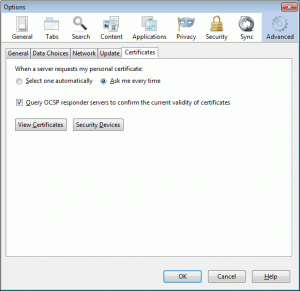
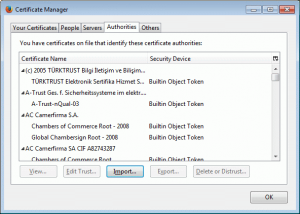
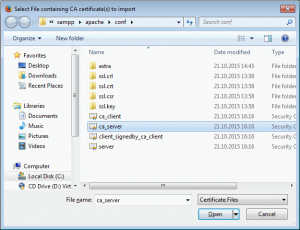
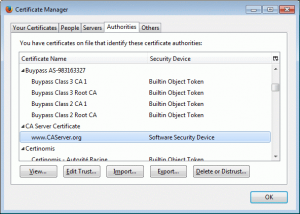
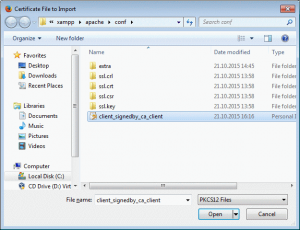
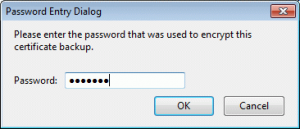
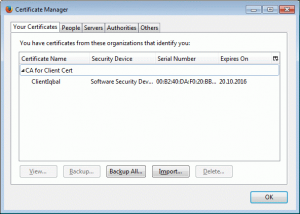
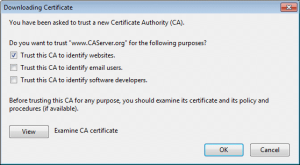
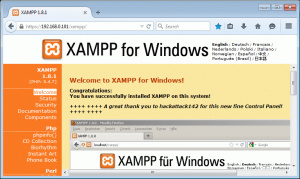
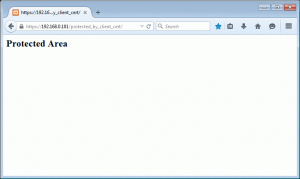


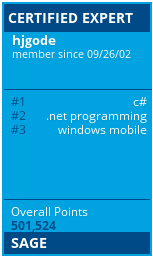

 http://www.led-mg.de
http://www.led-mg.de